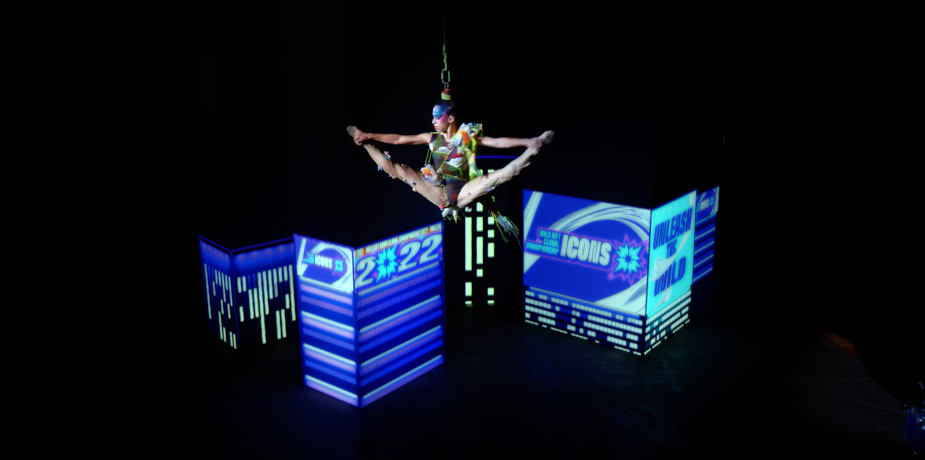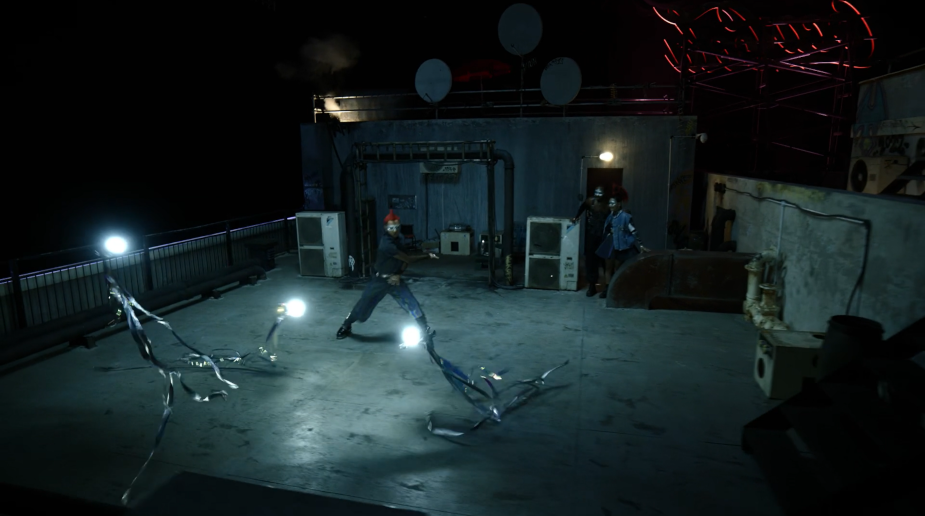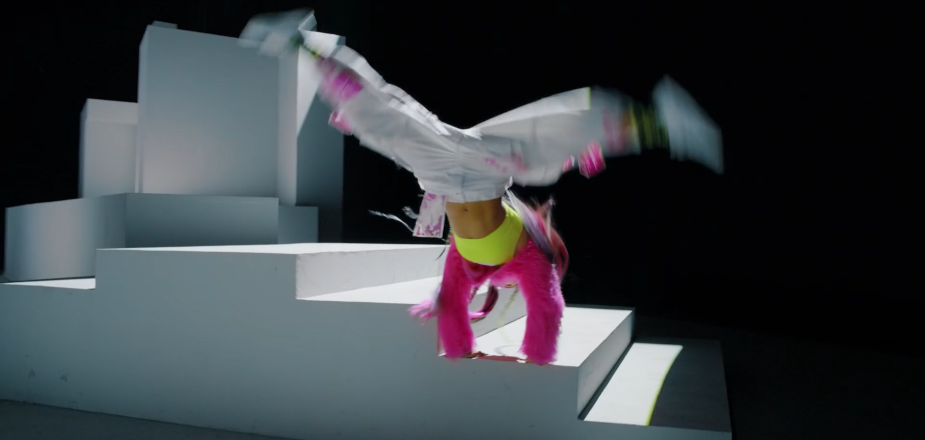‘Wild Rift’ is one of those creative projects that’s hard to put in a box. Part launch film, part virtual opening ceremony, part music video, part trailer… Whatever it is, watching it is quite an experience.
The film transports a troupe of stunningly styled, talented and diverse performers into an intricately designed future fantasy Singapore where they unleash their wild sides.
Ross Cooper is the director behind the project, which has been created for the League of Legends – Wild Rift Icons Global Championship – the crowning event of the Wild Rift esports year. League of Legends: Wild Rift is a multiplayer online battle arena mobile game developed and published by Riot Games for Android and iOS. The free-to-play game is a modified version of the PC game League of Legends.
Pandemic restrictions in China forced the cancellation of the live opening ceremony in a stadium. So, instead, League of Legends pivoted at very short notice to produce an opening ceremony film to run ahead of the live streamed event.
This switch left the team with an incredibly tight production and delivery deadline: only seven days to edit, post and finish an SFX-heavy, six-minute film whose end frame, a rising crane shot of a night market, resolved into a forced perspective logo in the shape of the championship trophy that had to seamlessly transition into the opening moving camera shot of the live broadcast of the finals in Singapore.
It was also a particular challenge to work out how to reflect the game’s mix of high fantasy, steampunk, Lovecraftian horror, filled with magical spells, blue fire breathing space dragons and undead robotic mummies into a post-production-free in-camera world.
Johnny Foreigner signed Ross on the back of securing him the film, which, in the words of the company’s founder Olivia Hirschberg, is, “probably the most spectacular piece of film-making I’ve ever been associated with.”
Brief
“The original script was pretty loose,” says Ross, who appreciated the freedom to develop the story, suggest ideas, invent techniques and create new sequences to showcase the performers inherited from the cancelled live event.
The brief, he says, was to “celebrate these diverse performers” as they “unleashed their wild sides in a world alive with colour”. Ross was also charged with peppering the film with as many Wild Rift Easter eggs as possible, to reward the game’s obsessive fans.
Ross’ Approach
The project’s specific constraints meant that the director’s approach to this job was threefold. Ross lays out his rules:
1. Practical Effects First. Since all the cast were performing for real, so should we. We aimed to do as much of everything in-camera as possible; with practical effects; in-camera scenes, clothing and lighting transitions; and as little post production as possible. There would be little room for error and it was more a case of ‘fix it in pre-production’.
2. Use the most effective camera technique for each performer’s talent. Each ‘Wild Sider’ had a unique talent, and the best way to capture the thrill of their live performance was to use the most appropriate and often unique camera techniques to capture it.
3. Use long unbroken takes. Long takes would allow the performers to shine and to demonstrate that they are doing these amazing tricks for real.
The film became what Ross calls, “an extravaganza celebration of cross discipline in-camera craft.” He pays tribute to the expertise of everyone on the job. “From the speed and control of the lighting desk to the precision of the matte painters and model makers, to the inventiveness of the stylist George Buxton, to the splendour of the Natasha Lawes hair and makeup, the steady complicated crane grip work, the discipline of the flying riggers, the tightness of Adrian Gas’ choreography of not just dancers but drones and from Dan Betteridge’s stunning production design to Simon Chaudoir’s dazzling lighting and camerawork.”
The Shoot
The team had six days for a six-minute film with 11 main setups, and “not nearly as much time in pre-pro as I would have liked,” says Ross. “The shoot moved quite quickly and almost every set up had a specific particular challenge and technique.”
WARNING, list of impressive filmmaking jargon incoming from the director: “From designing a custom iPhone app and magnetic reversing trick nails, to multiple synced CRT TV’s, flying rigs, hair aerialists, projection mapping, parkour stunts, drone choreography, steadicam, MK-V AR rig, MōVI gimbal, precise crane work, motion control, a full musical song and dance section, forced perspective, glass matte paintings, miniatures, in-camera transitions, in-camera costume changes for a huge cast all with unique hair and makeup and a shot of some spinning red cabbage, which was another, on-the-day problem / solution that would have never passed a storyboard review, but now I can’t imagine the film without it.”
Easter Eggs
“The sheer amount of Easter eggs we added in the film really helped add depth and texture to the world that was created,” says Ross. Some were obvious, like the subterranean Elder Dragon skeleton below the streets of Singapore, others much more subtle, like the use of game elements in the design of the patterns and prints on the costumes, to the unmissable, like Singer Tkay’s stunning pink mirrored jacket in the shape of one of the game icons, to the last minute, like the X graffitied onto the ‘High Jinks’ neon shop sign, turning it into Jinx’s, the name of an important punk, game character. “Itself turning what was actually a typo into both an Easter egg and a pleasing last minute fix,” notes the director.
Custom iPhone App In-Camera Nails Trick
As an example of Ross’ practical effects first mantra, the whole phone / nail change sequence was shot in camera. Ross designed a custom iPhone app with ProtoPie prototyping software. An animation of the game glitching was created to match the cracked glass screen projector. The video of the glitching game screen transitioned into the image from the actual phone camera. A custom acrylic prism lens was attached to the phone camera to distort the image in-camera. In order to get the nails to appear in-camera, the team used custom Wild Rift nails which contained hidden magnets – and then more magnets in the palm of singer Tkay’s double’s hand. When she clenched her hand, the nails jumped off her fingers. They then reversed the footage of the whole sequence, so the nails look like they magically appear when she passes the magical camera over her hand.
Cast and Performers
“Tkay was a wonderful patient lead,” says Ross. “She brought a great energy to the project and bravery in performing around the often intimidating motion control camera.” Tkay’s costume hair and makeup change was one of the few planned post-production shots in the film. So the team scheduled that shot early in the production to give the team at post house Big Buoy [now Tag Collective Arts] time to work on that transition. Meanwhile, the rest of the shoot continued.
Because of the sheer number and complexity of elements to shoot in the time and the short delivery window, during occasional short breaks in the shoot Ross took to filming himself watching rough cuts of the edit and recording real-time verbal notes on what was and wasn’t working, which the editors would then sync to the film and playback at their own pace.
“Samuka the Brazilian b-boy was such a pleasure to work with,” says Ross. “His skills are self-evident. The camera roll controlled with the accelerometer in an iPhone was an attempt to capture the thrill of seeing his stunning somersault in person.

“Elena was our delightful LA-based hair aerialist, she really does tie her hair into a bun and then into a knot round a steel ring, then with a few minutes to warm up her scalp, gradually putting more tension on it till she’s ready to fly. She had only ever flown straight up and down in her stage act, itself an impressive enough feat, but we wanted her to fly across the stage and then pinpoint land on the balustrade of the rooftop set. She easily perfected this new skill in record time.”
For the final shot of the film, when all the cast apart from Elena freeze, the team shot her impressive first rehearsal. She then asked them if we wanted to see a really quick-spinning version. “Since everyone was supposed to stay still we were worried that they would be distracted by her performance,” says Ross. “So we made it very clear that no one should look at her. Everyone did as directed and only on cut did the cast and crew break out into spontaneous rapturous applause.”

Drones
The scene with one of the other performers, Ainsley Hall Ricketts, dancing with drones had originally been planned to use a 3D formation drone display company. They would pre-program the drones to fly on a fixed 3D path following the ordained choreography. But this proved problematic because the drones cannot fly as accurately when they are inside a building – the GPS signals work less well. And because the drone movement is key framed in 3D software, it wasn’t something that could be dynamically developed with the dancer, steadicam and choreographer in real time. To resolve this, Ross suggested they get drone FPV (first person view) pilots and treat them exactly like dancers, getting the drone pilots to experiment, develop and learn the choreography.
Ross reflects on the strange moment this led to: “To see the three FPV drone pilots, all sitting in a row, wearing their First Person View headsets heads nodding to the beat while the assistant choreographer Lianne Lee May stood shouting cues over the buzz of the drones, scolding them to keep time, ‘1,2,3 heel, twist,’ while Ainsley the dancer and Rick the steadicam operator gamely negotiated being in the centre of the maelstrom, trusting the pilots to keep to their routine. They were particularly brave as occasionally one of the drones would suck the tails from another drone into its motors, sending it crashing into the deck. The drones were very light and had rotor protectors so were perfectly safe to fly close to people, but still.”
The idea of adding tails to the drones was to make them more visually interesting, organic looking, and to make it obvious that the drones were really there and not added in CG. “The amazing fabric for the dancers’ outfits, sourced by George Buxton would turn from nearly black to glowing rainbow bright in-camera,” says the director. “While the clothing reacted to the LEDs on the drones, Simon Chaudoir used a manually triggered front light on the steadicam to give us the full blast of in-camera colour change.”
Apart from looking amazing, George Buxton the stylist wanted all the costumes to also be as sustainable as possible. Setting herself a target of 90% of the costume coming from hiring, buying second hand, using her own stock and up-cycling. Which she achieved successfully.
Plus, many of the film’s Easter eggs from within the game feature in the costumes – whether as decorative elements with screen printing, fabric printing, studding and jewellery all taken from the game, or the shapes of garments echoing graphics from the game.

Parkour
The impressive parkour sequences required clever production design to show off the athletes’ skills to the max. The parkour chimney set, after athlete Taylor Carpenter jumps off the building, was actually constructed leaning at a 45-degree angle. “This meant that we could make her descent look even more exciting,” reveals Ross. She could safely leap the fence, catch the ledge then do a somersault drop over 20 feet without wires.
“[Production designer] Dan [Betteridge]’s design for the main parkour was beautiful,” he says. Dan worked with choreographer Adrian and the parkour athletes to tweak the design to their specifications and to best showcase their unique styles of parkour. The team also worked with a parkour cinematographer Daniel Ilabaca to develop the routines and really get the camera up close to see the performers’ skill.
“Taylor’s combination of choreography, performance and costume, demonstrates a compelling sense of power,” says the director. “The other parkour tracers Ed, George and Travis flawlessly mixed skill, professionalism and bravery to create a stunning routine. George’s side somersault onto a pillar barely bigger than his own footprint was particularly impressive. He used a t-shirt as a marker to rehearse the jump at ground level before moving up into the air to make the jump and perfectly hit the pillar. With the rest of the parkour team encouraging and supporting his impressive stunt. Even just watching from the monitor, primed me to think I could leap about the set like a much nimbler man, fortunately the team only needed two takes as they were both perfect, so there really was no time for me to embarrass myself any further.
“I was so fortunate that producer Joe Myers and Lucky Strike productions put together such a fantastic crew who were all at the top of their game. It was an incredible experience, to behold such fantastic performers, doing amazing things in beautiful set ups for real. As the estimable Simon Chaudoir described it, ‘there were so many moments of intense joy shooting this’, well in between the other moments being tormented by the interminable beeps of hundreds of angry sounding cherry pickers. But overall it made me so incredibly grateful to have one of the best jobs in the world.”
Credits
Director: Ross Cooper
Producer: Joe Myers
Production Company: Lucky Strike Productions
Directors Agent: Johnny Foreigner
Exec Producer: Phil Haselden
Line Producer: Igor Degtiarev
Production Manager: Marketa Husecka
DOP: Simon Chaudoir
Production Designer: Dan Betteridge
Costume Designer: George Buxton
Make Up & Hair Designer: Natasha Lawes
Client: Riot Games
Riot Creative Director: Charlie Anderson
Riot Producer: Pat Doyle
Riot Production Manager: Callum Burns
Choreographer: Adrian Gas
Assistant Choreographer: Lianne Lee May
Artist: Takudzwa ‘Tkay’ Maidza
Artist Manager: Sasha Chifura
B.Boy: Samuel ‘Samuka’ Da Silveira Lima
Hair Hanging Artist: Elena Suarez Pariente
Drone Conductor: Ainsley Hallricketts
Parkour Athlete: Taylor Carpenter
Parkour Athlete: Ed Scott
Parkour Athlete: Travis Vervaik
Parkour Athlete: George Mcgowan
Production Assistant: Georgia Mcclure
Production Assistant: Suzan Mustafa
Cast Coordinator : Maisie Spratt
Transport Coordinator: India Plummer
Security Pass Production Assistant: Clara Grace
Script Supervisor : Mo Johnstone
1st Ad: Ben Gill
2nd Ad : Chris Mears
3rd Ad: Denis Nortey
3rd Ad Runner: Kitty Rajakulasingam
Runner: Cian Llewellyn
Runner: Sidney Kwok
Runner: Kai Rajakulasingam
Runner: Hugo Foley
Runner: Kwesi Mcdleod
Runner: Rio Savvaris
Runner: Alex Degtierev
Carriage Girl: Luisa Page
Smart Commuter: Birkramjit Gurm
Wok Chef: Ian U’chong
Phone Knocker: James Mulford
Young Tourist : Andres Query
Reverse Woman: Lina Guarin
Metro Worker: Emi Ichikawa
Business Woman: Hiromi Toyooka
Beatboxer: Fortune Jordane
Drone Dancer: Kieran Daley-Ward
Drone Dancer: Becky Wong
Dancer: Nicole Valverde
Dancer: Martha Gimson
Dancer: Leanne Horsey
Dancer: Vikki Clarke
Dancer: Darcey Simmons
Dancer: Billy Sawyer
Dancer: Kenji Mutsunaga
Dancer: Ryan Hayes
Dancer: Marko Stamkovic
Dancer: Armando Cruz
Dancer: Josh Gill
Dancer: Ines Galvares
Dancer: Phil Birchall
Dancer: Charlotte Hawthorne
Dancer: Mina Neighbour
Dancer: Hayley Monhangan
Dancer: Abz Kareem
Steadicam: Rick Woolard
A Cam 1st AC: Charlie England
A Cam 2nd AC : Tara Bulten
B Cam 1st AC : Tim Allan
B Cam 2nd AC: Jenny John Chuan
Camera Trainee: Crescencio Ferreira
DIT: Nelson Oliver
Video Playback: Karl Taggart
Moco Op: Tom Keeling
Moco Assistant: Tom Ravescroft
Moco Assistant: Kevin Culmer
Script Supervisor: Mo Johnstone
Parkour Cam Op: Daniel Ilabaca
Singapore Prod: Mark Sim
Singapore DOP: Reynard Lee
Art Director: Kate Mcconnel
Art Director: Marriane Gallagher
Art Director: Jenny Selden
Set Decorator: Anna Lynch Robinson
Prop Master: Chris Brett
Prop Master : Lloyd Vincent
Prop Man: Lester Hill
Prop Man: Dan Underwood
Art Assis: Bailey Betteridge
Hod Scenic Painter: Craig Carpenter
Matte Painter: Leigh Took
Matte Painting Assis: Sonia Latchford
Storyboard Artist: Jane Clark
Key Grip: Pete Olney
Louma: Adam Samuelson
Mini Libra Tech: Josh Milne
Crane Head Op: Lawrence Bewsher
Crane Op: James Duffy
Gaffer: Steve Finberg
Best Boy : Dan Fontaine
Lighting Desk Op: Andy Walton
Head Rigger: Pat Daly
Flying Rig: Ben Haynes
Flying Rig: James Pearce
Flying Rig: Lee Stephenson
Drone Pilot: Mike Foyle
Drone Spotter : Lawrence Randell
Drone Pilot: Josh Henriques
Drone Spotter : Emmanuel Holcroft
Drone Pilot: Louis Houiler
Drone Spotter : Lucian Wisniewski
Costume Supervisor: Jessica Johnston
Costume Assistant: Pia Woodvine
Costume Assistant: Amy Laverack
Costume Assistant: Nancy Kane
Costume Assistant: Aimee Blowers
Costume Assistant: Gabbi Edmunds
Tailor: Carson Darling Blair
Tailor : Vicky Tarbuck
Tailor : Soraia Samju
Tailor : Faye Oakenfull
Hairdresser / Supervisor: Judit Florenciano
Make Up / Hair / Nails: Anya Mcdevitt
Make Up Artist: Marta Wozniak
Make Up / Hair : Holly Miller
Make Up / Hair : Kamila Kornini
Make Up / Hair : Anthony Tester
Make Up / Hair : Jane Arnold
Make Up / Hair : Jaz Lanayero
Make Up / Hair : Kerri Clarke
Make Up / Hair : David Sesmero
Make Up / Hair : Jenny Green
Make Up / Hair : Emily Chaplin
Make Up / Hair : Elsa Isaku
Make Up / Hair : Ruth Pease
Event Projection: Craig Westwood
Event Projection: Steven Johnson
Post Prod Company: Big Buoy
Post Producer: Neuma Lluisa Dos Santos
Vfx Supervisor: Angus Wilson
Offline Editor: Laurence Halstead
Offline Editor: Matt Felstead
Edit Assist: Fraser Eldred
Sound Design & Sound Mix: Nick Olsouzidis
Vfx: Tim Davies
Vfx: Richard ‘Stretch’ Russell
Vfx: Pete Hughes
Colour Grade: Mark Horrobin
Musical Director / Composer : Mark Yardley
Music Manager: Louise Smith
Music Composition : Michael Pitman
Music Composition : Richard Thomson
BTS Director / Camera: Guy Stephens
BTS 2nd Cam: Luke Atkinson
On Site Medic: Paul Mortimer
On Site Medic: Aaron Woodbridge
Health & Safety Officer: Aleksandra Lipinksa

Be the first to comment